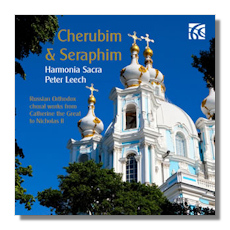
The Internet's Premier Classical Music Source
Related Links
-
Galuppi Reviews
Glinka Reviews
Rachmaninoff Reviews
Tchaikovsky Reviews - Latest Reviews
- More Reviews
-
By Composer
-
Collections
DVD & Blu-ray
Books
Concert Reviews
Articles/Interviews
Software
Audio
Search Amazon
Recommended Links
Site News
 CD Review
CD Review
Cherubim & Seraphim

Russian Orthodox Choral Works
from Catherine the Great to Nicholas II
- Dimitry Bortnyansky:
- Priiditye vospoim (Come and sing, O ye people)
- Da ispravitsya molitva (Let my prayer be set forth)
- Cherubic Hymn in D Major
- Oslavi mi da pochiyu (Remove thy gaze from me)
- Cherubic Hymn in F Major
- Giuseppe Sarti: Raduitesya lyudie (Rejoice, O ye people)
- Aleksandr Varlamov: Cherubic Hymn in G Major
- Mikhail Glinka: Ekteniya pervaya (Kyrie) Major
- Aleksei Fyodorovich Lvov: Cherubic Hymn #2
- Grigory Lvovsky: Cherubic Hymn in G Major
- Gavriil Yakimovich Lomakin: Cherubic Hymn #9
- Sergei Rachmaninoff: Bogoroditsye dyevo (Ave Maria)
- Baldassare Galuppi: Plotiyu usnuv (In the flesh thou didst fall asleep)
- Piotr Ilyitch Tchaikovsky: Dostoino yest (Blessing of the Virgin Mary)
Harmonia Sacra/Peter Leech
Nimbus Alliance NI6187 50min
Following Russian acceptance of the Orthodox faith from Greek-speaking Byzantium, a mixture of Greek and Slavic music emerged from the 11th century onwards. Although this music was generally permeated by chant, other similar forms took shape during the 15th and 16th centuries. Indeed, until the early 17th century, unaccompanied plainsong was the dominant form in Russian Orthodox liturgy, and the St. Petersburg Imperial Chapel Choir was still entrenched in a style that was heavily dependent upon homophony (block chords) with occasional contrapuntal experiments.
Only with the penetration of Western harmonic music by way of Ukraine and Poland, mainly through the efforts of Tsar Mikhail Romanov, did things start to change. With this opening up of Russia to outside influences, many Central European musicians and composers rushed to take up the many opportunities that presented themselves during the first decades of the 18th century. Following Catherine the Great's accession to the throne, Italian music spread very rapidly, and for the next two centuries most of the Orthodox choral pieces that were written were moulded "all'italiana".
This disc is precisely a collection of choral works composed by Italian and Russian composers between 1765 and 1915; 150 years of spine-tingling creations of sheer uplifting beauty. The programme includes 14 short pieces that vary from the profound to the prayerful, from the thankful to the rejoiceful, but each composition has that inescapable human yearning of wanting to be entwined with the divine. Harmonia Sacra under Peter Leech present this music in performances that are skilful, stylish and hugely attractive to the ear. The air is consistently tender rather than forcefully dramatic, and the great attention to detail readily discloses all the subtleties of these quite inspiring gems. Sound and annotations are first-rate, but the 50 minutes playing time might induce some reservations. But this is only a minor glitch in what is a very fine issue that should be snapped up without hesitation.
Copyright © 2012 by Gerald Fenech.


















